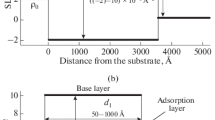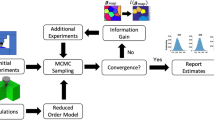Abstract
A comparison deals with the advantages and disadvantages of the classical random-base, exhaustive and gradient searches and presents a precise local search combined global search control strategy including a new, systematic point selection which makes possible the escape from local minima by time. As a demonstration electrochemically etched porous silicon (PS) samples were investigated by spectroscopic ellipsometry (SE). The evaluation process (a global optimisation task) was made in different ways to see the difficulties and the differences among the evaluating possibilities. The new, topographical search (named Gradient Cube search) was compared with some classical methods (Grid search, Random or Monte-Carlo search, and Levenberg-Marquardt gradient search) and with two more complex algorithms (Genetic Algorithms and Simulated Annealing) by evaluating real measurements. The application results prove that the classical methods have difficulties to give enough reliability and precision at the same time in global optimisation tasks if the error surface is hilly. There is therefore a hard need of escaping from local minima, and a need of a systematic evaluation to avoid the uncertainty of random-base evaluation. The Gradient Cube search is an effective, systematic hill-climbing search with high precision and so it can be useful in ellipsometry.
Similar content being viewed by others
References
Azzam, R.M.A. and Bashara N.M. (1977) Ellipsometry and Polarized Light, North-Holland, Amsterdam.
Collins R.W., Aspnes D.E. and Irene E.A. (eds) (198*), Thin Solid Films, Proc. of 2nd Int. Conf. on Spectroscopic Ellipsometry, 313-314 and papers therein.
Dekkers, A. and Aarts, E. (1991), Global Optimization and Simulated Annealing, Mathematical Programming 50: 367-393.
Fletcher R. (1971), A Modified Marquardt Subroutine for Non-Linear Least Squares, U.K.A.E.A. Research Group, Atomic Energy Research Establishment, Harwell.
Fried M., Lohner T., Polgár O., Petrik P., Vázsonyi É., Bársony I., Piel J.P. and Stehle J.L. (1996), Characterization of different porous silicon structures by spectroscopic ellipsometry, Thin Solid Films 276: 233.
Goldberg D.E. (1989), Genetic Algorithms in Search, Optimization & Machine Learning (p. 126) Addison-Wesley, Reading, Mass.
Holland J.H. (1975), Adaptation in Natural and Artificial Systems, University of Michigan Press, Ann Arbor, MI.
Jellison, Jr. G.E., Chisholm M.F. and Gobatkin S.M., Optical Functions of Chemical Vapor Deposited Thin-Film Silicon Determined by Spectroscopic Ellipsometry, Appl. Phys. Lett. 62: 348.
Kirkpatrick, Jr, S., Gelatt C.D. and Vecchi M. (1983), Optimization by Simulated Annealing, Science 220: 671-680.
Moré, J. (1977), The Levenberg-Marquardt Algorithm: Implementation and Theory, Numerical Analysis, (G.A. Watson, Ed.), Lecture Notes in Math. 630. Springer Verlag, Berlin.
Rich Elaine and Knight Kevin (1991), Artificial Intelligence, McGraw-Hill, Inc.
Vanhellemont, J., Maes, H.E. and De Veirman, A. (1991), Spectroscopic Ellipsometry Studies of SIMOX Structures and Correlation with Cross-Section TEM. Vacuum 42: 359-365.
Author information
Authors and Affiliations
Rights and permissions
About this article
Cite this article
Polgár, O., Fried, M., Lohner, T. et al. A Combined Topographical Search Strategy with Ellipsometric Application. Journal of Global Optimization 19, 383–401 (2001). https://doi.org/10.1023/A:1011297022280
Issue Date:
DOI: https://doi.org/10.1023/A:1011297022280




